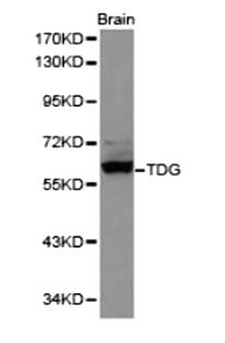TDG Antibody
Rabbit Polyclonal Antibody
- SPECIFICATION
- CITATIONS
- PROTOCOLS
- BACKGROUND

Application
| WB, IHC |
|---|---|
| Primary Accession | Q13569 |
| Reactivity | Human, Mouse, Rat |
| Host | Rabbit |
| Clonality | Polyclonal |
| Isotype | Rabbit IgG |
| Calculated MW | 46053 Da |
| Gene ID | 6996 |
|---|---|
| Positive Control | Western Blot: Brain cell lysates |
| Application & Usage | Western blot: 1:500 – 1:1000. |
| Other Names | TDG. |
| Target/Specificity | TDG |
| Antibody Form | Liquid |
| Appearance | Colorless liquid |
| Formulation | 100 µg of antibody in 100 µl PBS containing 0.02% sodium azide, 50% glycerol, pH 7.3 |
| Handling | The antibody solution should be gently mixed before use. |
| Reconstitution & Storage | -20 °C |
| Background Descriptions | |
| Precautions | TDG Antibody is for research use only and not for use in diagnostic or therapeutic procedures. |
| Name | TDG |
|---|---|
| Function | DNA glycosylase that plays a key role in active DNA demethylation: specifically recognizes and binds 5-formylcytosine (5fC) and 5-carboxylcytosine (5caC) in the context of CpG sites and mediates their excision through base-excision repair (BER) to install an unmethylated cytosine. Cannot remove 5-hydroxymethylcytosine (5hmC). According to an alternative model, involved in DNA demethylation by mediating DNA glycolase activity toward 5-hydroxymethyluracil (5hmU) produced by deamination of 5hmC. Also involved in DNA repair by acting as a thymine-DNA glycosylase that mediates correction of G/T mispairs to G/C pairs: in the DNA of higher eukaryotes, hydrolytic deamination of 5-methylcytosine to thymine leads to the formation of G/T mismatches. Its role in the repair of canonical base damage is however minor compared to its role in DNA demethylation. It is capable of hydrolyzing the carbon-nitrogen bond between the sugar-phosphate backbone of the DNA and a mispaired thymine. In addition to the G/T, it can remove thymine also from C/T and T/T mispairs in the order G/T >> C/T > T/T. It has no detectable activity on apyrimidinic sites and does not catalyze the removal of thymine from A/T pairs or from single- stranded DNA. It can also remove uracil and 5-bromouracil from mispairs with guanine. |
| Cellular Location | Nucleus. |

Thousands of laboratories across the world have published research that depended on the performance of antibodies from Abcepta to advance their research. Check out links to articles that cite our products in major peer-reviewed journals, organized by research category.
info@abcepta.com, and receive a free "I Love Antibodies" mug.
Provided below are standard protocols that you may find useful for product applications.
Background
In the DNA of higher eukaryotes, hydrolytic deamination of 5methylcytosine to thymine leads to the formation of G/T mismatches. G/T mismatch specific Thymine DNA Glycosylase (TDG) is a nuclear protein which corrects G/T mismatches to G/C pairs by hydrolyzing the carbon nitrogen bond between the sugar phosphate backbone of the DNA and the mispaired thymine. TDG also corrects a subset of G/U mispairs inefficiently removed by the more abundant uracil glycosylases. Retinoic acid receptors interact physically and functionally with TDG, enhancing the ability of the retinoid X receptor and the retinoid X receptor/retinoid acid receptor complex to bind to their response elements. TDG interacts with, and is covalently modified by, the ubiquitinlike proteins SUMO1 and SUMO2/3, resulting in a reduction of the DNA substrate and AP site binding affinity of TDG. This sumoylation is associated with a significant increase in enzymatic turnover in reactions with a G/U substrate and the loss of G/T processing activity.
If you have used an Abcepta product and would like to share how it has performed, please click on the "Submit Review" button and provide the requested information. Our staff will examine and post your review and contact you if needed.
If you have any additional inquiries please email technical services at tech@abcepta.com.













 Foundational characteristics of cancer include proliferation, angiogenesis, migration, evasion of apoptosis, and cellular immortality. Find key markers for these cellular processes and antibodies to detect them.
Foundational characteristics of cancer include proliferation, angiogenesis, migration, evasion of apoptosis, and cellular immortality. Find key markers for these cellular processes and antibodies to detect them. The SUMOplot™ Analysis Program predicts and scores sumoylation sites in your protein. SUMOylation is a post-translational modification involved in various cellular processes, such as nuclear-cytosolic transport, transcriptional regulation, apoptosis, protein stability, response to stress, and progression through the cell cycle.
The SUMOplot™ Analysis Program predicts and scores sumoylation sites in your protein. SUMOylation is a post-translational modification involved in various cellular processes, such as nuclear-cytosolic transport, transcriptional regulation, apoptosis, protein stability, response to stress, and progression through the cell cycle. The Autophagy Receptor Motif Plotter predicts and scores autophagy receptor binding sites in your protein. Identifying proteins connected to this pathway is critical to understanding the role of autophagy in physiological as well as pathological processes such as development, differentiation, neurodegenerative diseases, stress, infection, and cancer.
The Autophagy Receptor Motif Plotter predicts and scores autophagy receptor binding sites in your protein. Identifying proteins connected to this pathway is critical to understanding the role of autophagy in physiological as well as pathological processes such as development, differentiation, neurodegenerative diseases, stress, infection, and cancer.


